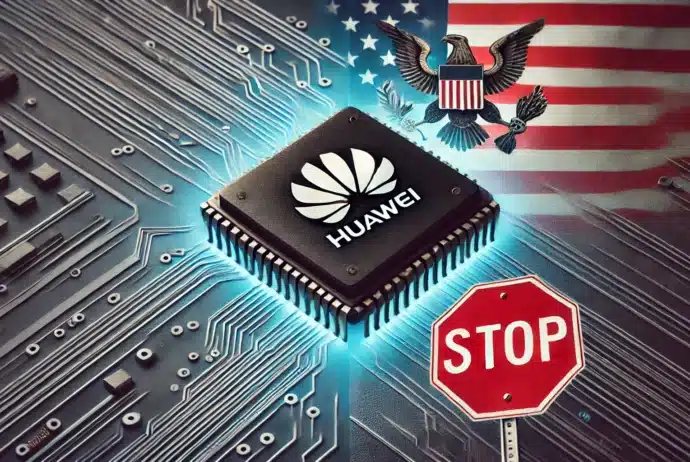Key Insights:
- US sanctions block Huawei’s access to critical EUV lithography, halting progress on advanced AI and smartphone chips.
- SMIC struggles with low yields in 7nm chip production, affecting Huawei’s ability to meet processor demand.
- Huawei explores costly multi-patterning methods, but quality issues with local equipment hinder mass production efforts.
Huawei Technologies Co. is facing major setbacks in its quest to develop cutting-edge chips for artificial intelligence and smartphones due to ongoing US restrictions. These curbs are preventing the company from accessing the latest chipmaking technologies, limiting its ability to compete with global leaders such as Nvidia and Apple.
The Chinese tech giant is currently designing its next-generation Ascend processors on 7-nanometer (nm) architecture. This technology, while once a benchmark for advanced semiconductors, has become dated as leading manufacturers are now transitioning to 3nm and even 2nm processes.
Sources familiar with Huawei’s operations have indicated that the company will likely remain stuck with this technology until at least 2026.

CypherMindHQ.com Artificial Intelligence Crypto Trading System - Surpass the competition with this cutting-edge AI system! Utilize the prowess of innovative algorithms and amplify your crypto trading strategies with CypherMindHQ. Learn more today!
Restrictions on Equipment Limit Technological Progress
At the heart of the problem is Huawei’s inability to procure extreme ultraviolet (EUV) lithography systems from ASML Holding NV. These machines are essential for producing semiconductors with smaller nodes like 5nm or below. Without them, Huawei has had to rely on older deep ultraviolet (DUV) lithography systems, which lack the precision and efficiency of EUVs.
The Biden administration has further tightened export controls, restricting Huawei’s access to high-end equipment from American suppliers, including Applied Materials and Lam Research. According to analysts, these restrictions are keeping Huawei from advancing its chip designs to match global standards.
In an attempt to overcome these barriers, Huawei and its manufacturing partner, Semiconductor Manufacturing International Corp. (SMIC), have explored advanced techniques such as multi-patterning. This process involves using DUV machines to layer multiple patterns on silicon wafers. However, it introduces increased risks of defects and raises production costs.
Challenges in Mass Production with SMIC
SMIC, which produces chips for Huawei, is also struggling to scale its 7nm production. Sources have reported persistent issues with low yields and unreliable output, making it difficult to produce chips in the required volumes. These production challenges are likely to affect Huawei’s ability to meet demand for its Kirin-branded smartphone processors and Ascend AI chips.
Analysts have raised concerns about the feasibility of SMIC’s reliance on multi-patterning techniques. Ying-Wu Liu, an expert at research firm Yole Group, explained that “multi-patterning inherently increases the number of process steps, which amplifies the risk of errors.” He also noted that this approach is less cost-effective for producing chips at advanced nodes like 5nm.
Some trial production lines have reportedly had to replace Chinese-made equipment with imported machinery to improve efficiency, raising doubts about China’s readiness to scale advanced semiconductor production domestically.
Huawei’s Smartphone Line Faces Delays
The effects of these challenges are becoming apparent in Huawei’s consumer business. The company has delayed the launch of its next flagship smartphone, the Mate 70, set to be unveiled on November 26. Unlike previous launches, Huawei has refrained from promoting any new hardware features or processor details ahead of its release.
This stands in stark contrast to the debut of the Mate 60 Pro last year, which featured a domestically produced 7nm chip from SMIC. That device became a symbol of Huawei’s resilience, helping the company achieve several consecutive quarters of growth. However, experts now question whether Huawei can maintain that momentum under the current circumstances.

CypherMindHQ.com Artificial Intelligence Crypto Trading System - Outpace the competition with this high-end AI system! Leverage the capabilities of progressive algorithms and enhance your crypto trading performance with CypherMindHQ. Learn more today!
The company’s recent focus has shifted toward promoting its Harmony operating system, signaling a potential pivot in its strategy as it grapples with technological hurdles.
Domestic Equipment Faces Quality Concerns
Efforts to build a self-reliant semiconductor supply chain in China have encountered additional obstacles due to the inferior performance of domestic equipment. Beijing has urged its chipmakers to adopt local machinery to reduce reliance on foreign technology. However, sources have indicated that some of this equipment has fallen short of production standards.
Engineers working on trial production lines have reportedly faced difficulties using Chinese-made lithography tools alongside ASML’s DUV systems. In some cases, they have been forced to revert to foreign equipment to achieve acceptable results.
Experts suggest that without access to EUV technology or substantial improvements in domestic machinery, China’s path toward producing advanced chips with smaller nodes will remain fraught with challenges. According to Liu, “The complexity of advanced semiconductor manufacturing will continue to pose economic and technical hurdles.”



